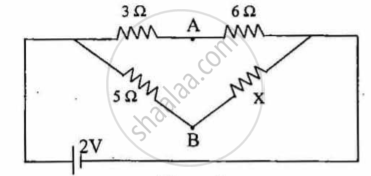Advertisements
Advertisements
प्रश्न
The heat developed in a system is proportional to the current through it.
विकल्प
It cannot be Thomson heat
It cannot be Peltier heat
It cannot be Joule heat
It can be any of the three heats mentioned above
उत्तर
It cannot be Joule heat
Joule heat is directly proportional to the square of the current passing through the resistor. Peltier heat is directly proportional to the current passing through the junction.Thomson heat is also directly proportional to the current passing through the section of the wire. Thus, the heat developed can be either Thomson heat or Peltier heat. But it cannot be Joule heat.
APPEARS IN
संबंधित प्रश्न
Show variation of resistivity of copper as a function of temperature in a graph.
Define the term 'conductivity' of a metallic wire. Write its SI unit.
Using the concept of free electrons in a conductor, derive the expression for the conductivity of a wire in terms of number density and relaxation time. Hence obtain the relation between current density and the applied electric field E.
Define current density. Write an expression which connects current density with drift speed
Define the term 'electrical conductivity' of a metallic wire. Write its S.I. unit.
The following figure shows a conductor of length l with a circular cross-section. The radius of the cross-section varies linearly from a to b. The resistivity of the material is ρ. Assuming that b – a << l, find the resistance of the conductor.

An electrolysis experiment is stopped and the battery terminals are reversed.
The specification on a heater coil is 250 V, 500 W. Calculate the resistance of the coil. What will be the resistance of a coil of 1000 W to operate at the same voltage?
A heater coil is to be constructed with a nichrome wire (ρ = 1.0 × 10−6 Ωm) that can operate at 500 W when connected to a 250 V supply. (a) What would be the resistance of the coil? (b) If the cross-sectional area of the wire is 0.5 mm2, what length of the wire will be needed? (c) If the radius of each turn is 4.0 mm, how many turns will be there in the coil?
For a metallic conductor, what is the relation between current density (J), conductivity (σ) and electric field intensity (E)?
In Figure 3 given below, find the value of resistance x for which points A and B are at the same potential:

figure 3
What is the colour code of a carbon resistor having a resistance of 470 Ω and a tolerance of 5%?
Assertion: Bending a wire does not effect electrical resistance.
Reason: Resistance of wire is proportional to resistivity of material.
The electric resistance of a certain wire of iron is R. If its length and radius are both doubled, then ______.
A constant voltage is applied between the two ends of a uniform metallic wire, heat ‘H’ is developed in it. If another wire of the same material, double the radius and twice the length as compared to the original wire is used then the heat developed in it will be -
Consider four conducting materials copper, tungsten, mercury and aluminium with resistivity ρC, ρT, ρM and ρA respectively. Then:
